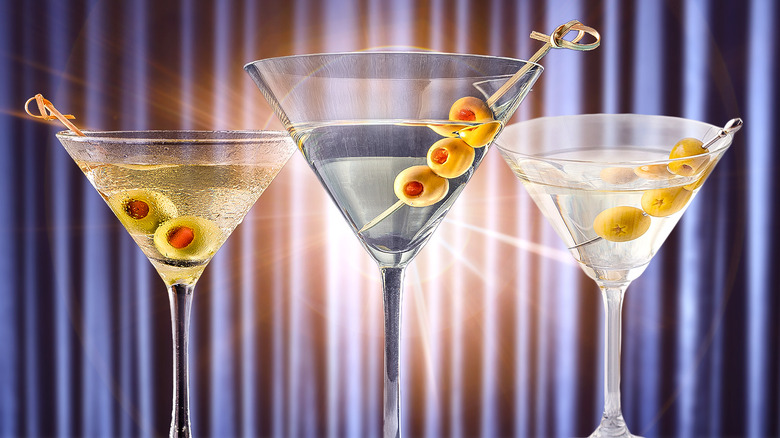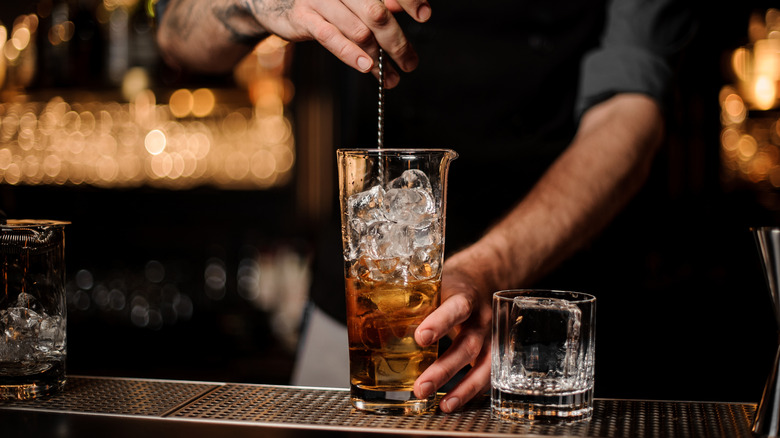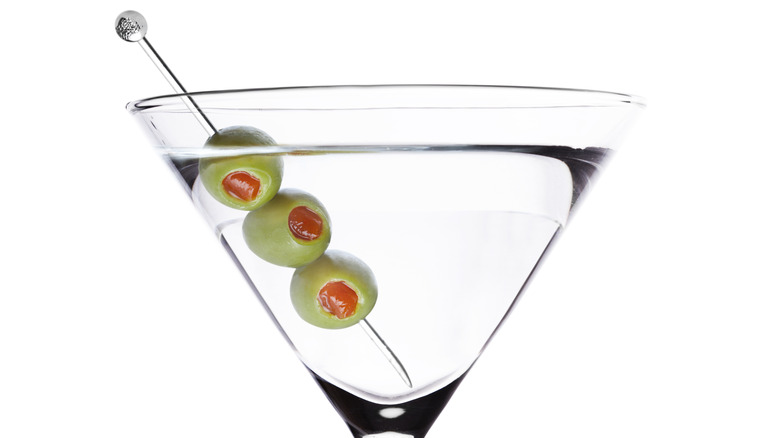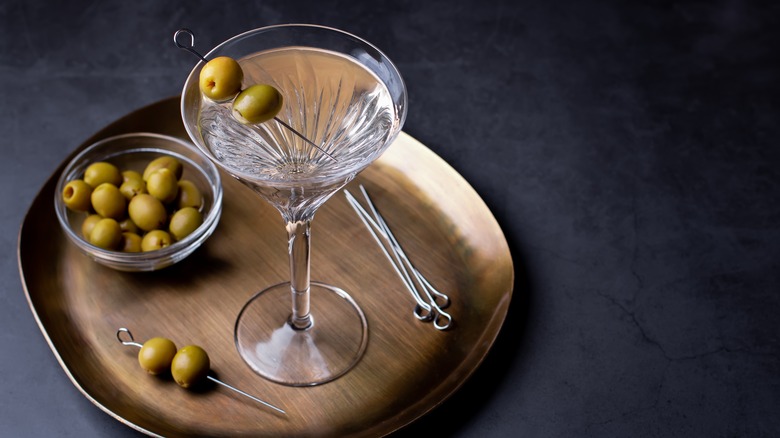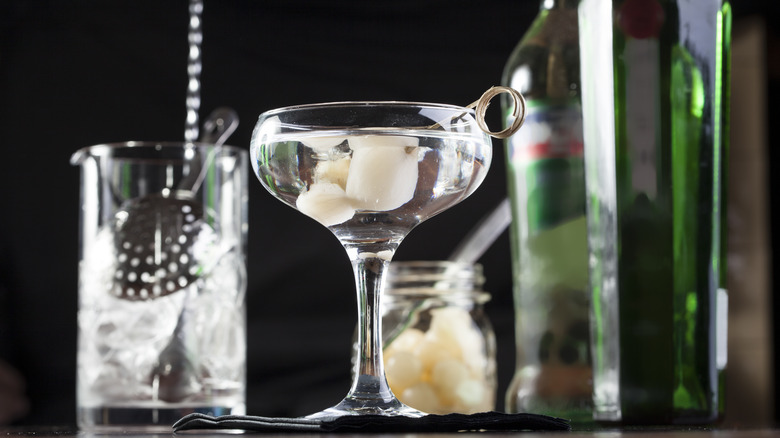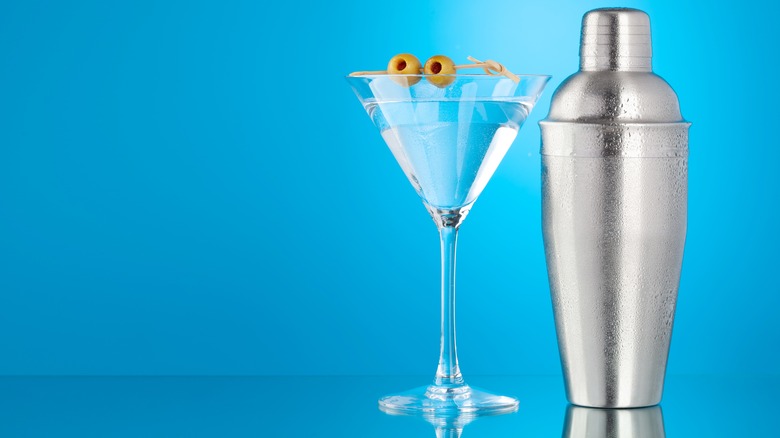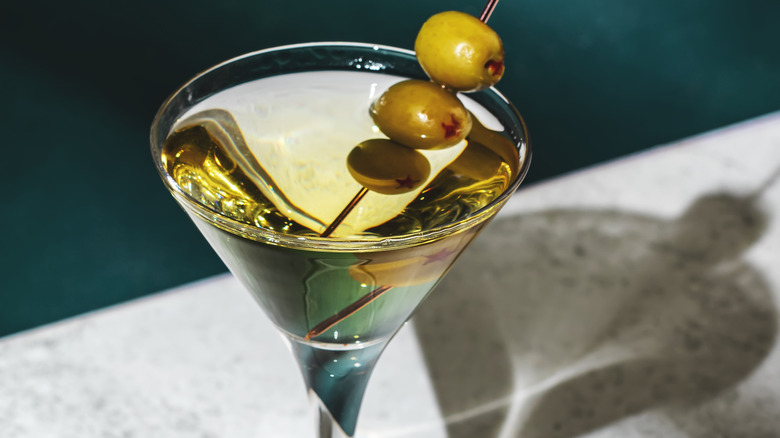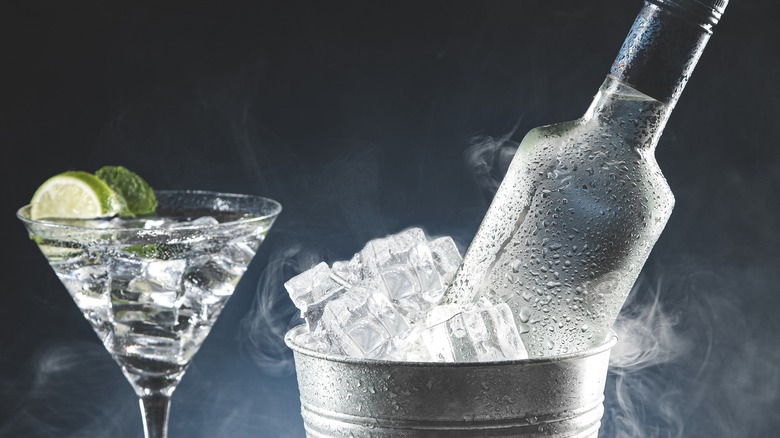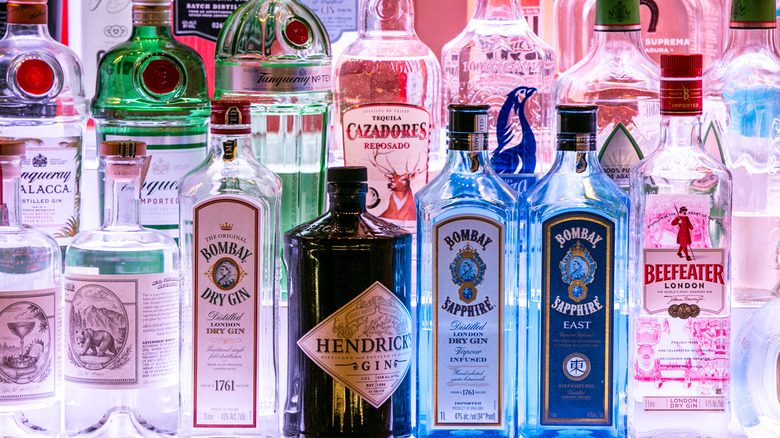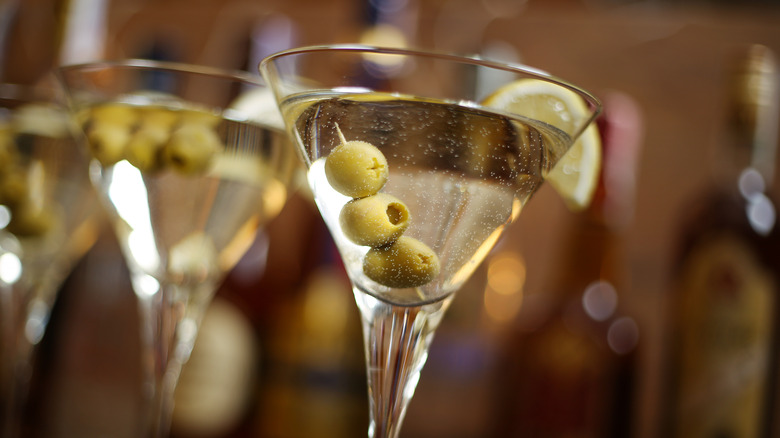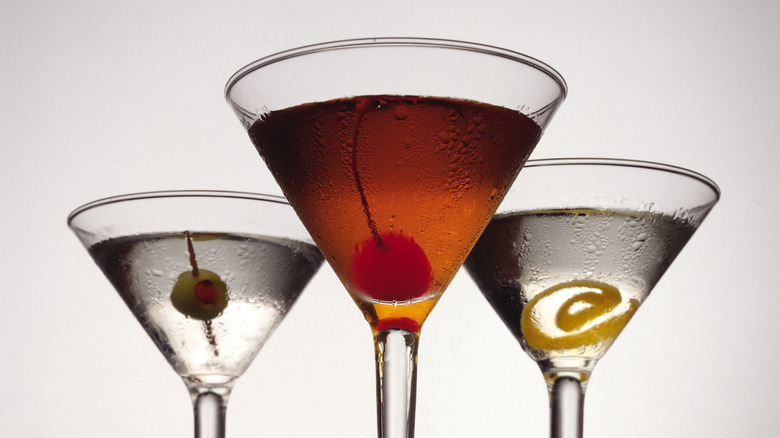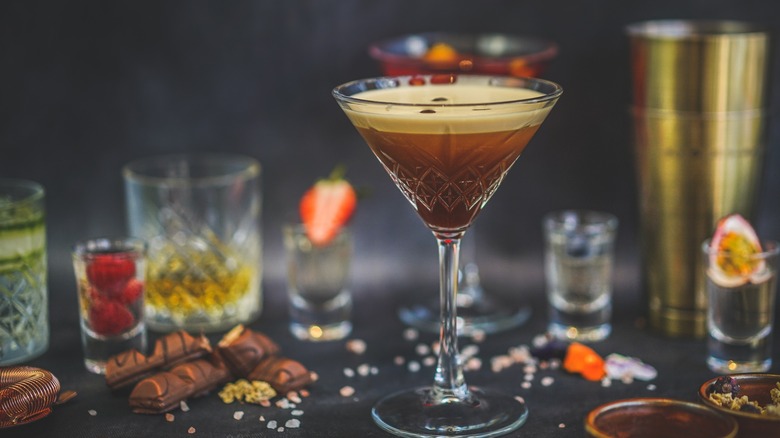12 Facts You Should Know About The Martini
The martini might just be the most famous cocktail in the world. Its invention is the stuff of legends, and the competing origin stories surrounding the drink attribute it to all kinds of people. One prevailing theory is that a successful San Francisco miner first ordered it during the Gold Rush. However, it truly began, the martini was cemented as both a drink and a status symbol by the mid-twentieth century. Since then, it has managed to maintain its heavyweight status; the image of the martini glass, complete with an olive or lemon twist, is that of a classic.
The original martini has only two ingredients: gin and vermouth. But while the original formula may be basic, the ways that martinis have been talked about, made, and tasted over time can feel complicated. There are a lot of facts about the martini to learn. Before you order your martini shaken, dry, or dirty, here's what you should know first.
A classic martini is shaken, not stirred
There may be hundreds of ways to make a martini, but one of the fundamental characteristics of a genuine classic martini is that it is stirred, not shaken. It's not just tradition for tradition's sake — there is logic to the rules for shaking versus stirring cocktails.
While shaking a martini with ice would undoubtedly cool it down, it would also break up the pieces of ice into the drink, creating a watery final product. Stirring keeps martinis boozy and ice-cold. Shaking also adds excess air, which alters the martini's mouthfeel and makes it cloudy when it should be clear. That's why classic cocktails made with just a few strong ingredients, like martinis or Manhattans, should be stirred.
With that said, shaking has its place, too. It works great for drinks with fruit juice or poured over ice. It helps combine and aerate ingredients in more complex cocktails that include sweeteners or egg whites. That's why recipes for martini riffs, like espresso martinis or cosmopolitans, often recommend pulling out the cocktail shaker.
Martini glasses serve both form and function
Martini glasses were not always synonymous with the classic cocktail. When cocktails first emerged, bartenders served them in champagne glasses. However, during the Art Deco period, the shape of cocktail glasses began to reflect the aesthetic of the time: drastic, sharply geometric shapes with more exaggerated proportions. Soon, the design became synonymous with the martini.
However, the shape of the martini glass has endured because it also highlights the critical elements of the drink itself. Since the stem is thin and long, you can hold the glass without raising the critically frosty temperature of a martini. The deep, conical cocktail glass holds around 8 ounces, and its shape highlights the elegance of a drink served without ice. The wide rim also sets a bigger stage for the aromas and flavors of the drink. A martini glass is still an excellent choice for a martini, but many bartenders and home mixologists prefer a coupe glass these days.
No one knows who invented the dirty martini
Dirty martinis are deliciously simple: add olive brine to a martini and enjoy. But its origins are more complicated. Just as the birth of the martini itself is shrouded in mystery, so is the invention of the dirty martini.
No one can be certain who first made the popular martini variation. Around the turn of the 20th century, bartenders started adding olive brine to the drink alongside the typical olive garnish; the rest is history. Franklin Delano Roosevelt is said to have been a huge fan and would add olive brine to his martinis while in the White House. Interestingly, while the dirty martini existed for many decades beforehand, the name "dirty martini" didn't come about until the 1980s.
Though the drink has a mysterious past, its continued popularity is certain. It is still a cocktail menu staple, and many bars now have their own versions; these days, olive brine is not the only way to make a dirty martini. Some bars even use lactic acid as a brine replacement.
Dry vermouth serves a particular purpose
When making a cocktail with as few ingredients as a martini, it is essential to know what exactly you are adding to the drink and why. A martini should always be made with dry vermouth. But what is dry vermouth, and why is it specifically used in this cocktail?
Vermouth is essentially fortified wine with botanicals added for additional flavor and aroma. While there are now many vermouth varietals, the two original types are the ones you need to know: dry and sweet. Sweet vermouth has a rich, warm flavor profile, while dry vermouth is more crisp and acidic. While sweet vermouth is great in cocktails like Manhattans, it's all wrong for a martini.
Dry varieties of vermouth are much less sweet, so they don't overpower gin's nuanced flavors and aromas. Plus, the light yellow color of vermouth preserves the lightness and clarity of the gin or vodka in a martini. Finding a dry vermouth should be pretty straightforward, but it's easy to get tripped up by cocktail jargon; don't forget, the more dry vermouth you add to a martini, the less "dry" it is.
Obama prefers his martinis a particular way
James Bond has caught a lot of flack for ordering his martini shaken, not stirred. But Barack Obama likes his extra-shaken — and who can argue with a former POTUS?
After he ordered his martini extra-shaken at the Honolulu restaurant Mahina & Sun's, the frothy and unorthodox version of a martini was put on the menu as a "Presidential Martini." Although it's not traditional, extra shaking has a purpose: it froths the drink, adding a lighter texture and ensuring the drink is ice cold while using less ice.
To make a martini fit for the Oval Office, add your vermouth and spirit of choice (Obama's martini was made with Grey Goose vodka) to a shaker, along with plenty of ice. Shake for at least 12 seconds — much longer than a typical shaken drink, but additional time is needed for the light and foamy texture. Pour into a glass and garnish with an olive to drink like a President.
Dry martinis were the result of bad vermouth
The terms "wet" and "dry" are commonly used when referring to martinis. At first, this may seem like a confusing way to describe liquids. But whether a martini is wet or dry is determined by the amount of vermouth used. Martinis, made from a combination of gin (or vodka) and vermouth, can contain anything from a full measure of vermouth to just a few drops to rinse the glass. The less vermouth, the drier the martini.
Historically, dry martinis have been the preferred style. That's because commercial vermouths of the past were typically of pretty low quality and were thought to muddle the flavor of the martini's base spirit. Dry martinis got drier over time, and during the 20th century, the preferred ratio of spirit to vermouth dropped from 3:1 to 6:1.But as vermouths have changed, maybe your martini order should, too. There is now an abundance of high-quality bespoke vermouths on the market, each with its own complex and distinct flavor profile. Now that the days of lousy vermouth are behind us try ordering a wet martini.
Ice-cold temperature is the third ingredient
While the ratios and ingredients of a martini may vary, one thing is nonnegotiable: the temperature. A martini has to be ice-cold. It's simple but imperative for letting the flavors shine, and it softens the bite of the high alcohol content of the drink. The freezing temperature is truly an ingredient in its own right — in fact, a "naked" martini is nothing but gin pulled straight from the freezer. Martini lover Martha Stewart counts an ice-cold finish among her best tips for making cocktails. Stewart emphasizes that the drink must be totally frosty to be a truly perfect martini.
With such high stakes, bartenders use many methods to keep their martinis cold. Keeping gin or vodka in the freezer is one crucial element, but many bars also keep their martini glasses in the freezer. Alternatively, some bartenders fill the glass with ice cubes while the drink is mixed and dump them before they pour.
A classic martini must be made with London dry gin
A martini may be traditionally made with gin, but that's only part of the story. The liquor itself has several subcategories based on distillation methods, base grains, and botanical ingredients. Martinis should be made with London Dry style gin.
You don't need to get it from England; while this gin originated in London, it can be made anywhere. Juniper berries are the main ingredient that gives all gins their flavor, but London Dry gins like Beefeater or Tanqueray are much more juniper-forward. London Dry gin must be predominantly flavored with juniper, though it is typically made with additional botanicals like cardamom and Angelica root. Its intensely herbaceous, slightly spicy profile plays well with dry vermouth, making it ideal for a martini. It also has less sugar than other varieties. You can mix up your martinis by using a different type of gin, like Old Tom or Plymouth, or swapping gin altogether for ever-popular vodka.
The three-martini lunch was class commentary
The phrase "three martini lunch" has been floating around since the middle of the twentieth century, but is it based on anyone's actual lunch habits? The answer is yes and no.
As the martini grew in popularity, so did its cultural capital. By the 1950s, martinis had become associated with Madison Avenue's chic and sophisticated ad executives. The idea was that they had the luxury of time and money to imbibe several strong cocktails during their lunch break. How popular a "three martini lunch" actually was for high-powered businessmen is up for debate, but the phrase itself represented a genuine economic and political divide in America.
Sometimes called a "two-martini" or "$50 martini" lunch, the phrase first appeared as part of a political campaign during Dwight D. Eisenhower's presidency. The campaign admonished Washington workers for their long, luxurious two-martini lunches. However, Jimmy Carter is the president who popularized the term when, during a 1976 presidential debate, he proclaimed that the working class of America would no longer tolerate the "50 dollar martini lunch." Thus, the lunch martini has come to symbolize how the lower classes subsidize the wealthy. Lunchtime cocktails are no longer standard in the corporate world, but the cultural association is likely here to stay.
Most martini riffs call for vodka, instead
While gin is traditional, vodka is the base spirit many people prefer when ordering a martini. For this reason, most bartenders will ask if you want gin or vodka in yours. While some of vodka's popularity may come down to a simple dislike of gin, its neutral flavor makes it a better choice when adding additional ingredients to a martini.
Technically speaking, a martini is meant to highlight the spicy herbal flavors of gin. However, after more than 100 years of changes to the martini, gin may not always be the best choice. As more ingredients are added to martini variations, like olive brine or fruit juice, the gin is less of a star ingredient and more of an intrusive presence that clashes with the overall mix. The prominent juniper flavor of gin can be overpowering, while vodka provides a blank canvas that allows bold new ingredients to shine. That's why you'll find gin in most lemon drop or espresso martini recipes.
Olives and lemon twists are the classic garnishes
Martinis are traditionally garnished one of two ways: with a skewer of cocktail olives or a lemon twist. Both garnishes complement martinis in their simplicity and flavor: olives play off the savory notes in the gin and vermouth, while lemon peel highlights the citrus and botanical elements of the drink.
Lemon twists have been around for as long as cocktails themselves, but the olive garnish is a newer innovation. Early cocktails were often garnished with a maraschino cherry. Both simple and visually pleasing, cherries were a sweet snack to finish your drink. But a drink made with dry vermouth, like a martini, clashes with the sugary flavor of a cherry. By the early twentieth century, olives began appearing in cocktail glasses. The new garnish stuck, and there are even superstitions surrounding the cocktail olive: one should always find one or three olives skewered in their glass. Two or four is bad luck.
There is no true martini recipe
Maybe it's counterintuitive, but there is no "real," true-blue martini recipe. Despite being one of the most popular cocktails in the world, with hotly debated rules and preferences for each of its elements, there is no single original recipe to reference. As strange as that may seem, it's fitting for a drink that has transformed so much over time: the entire history of martinis is a history of invention. One origin story for the martini even claims that the drink was itself a riff on a cocktail called the Martinez.
The beauty of a classic martini is in its simplicity: two ingredients, chilled and strained in a glass. But that simplicity also makes it an excellent canvas for creating something new. The basic formula of a martini can be altered in infinite ways. Martini riffs like the Vesper, lemon drop, dirty martini, and espresso martini have all become classics in their own right. The word "martini" has come to represent cocktails in general, as the suffix "tini" can be found tagged on to the end of almost any drink. There really are no rules, so don't be afraid to revamp this classic cocktail to make your dream martini; after all, the best martini is the one you love.
